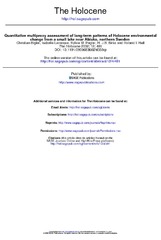| dc.description.abstract | Quantitative reconstructions are made of Holocene changes in climatic and environmental conditions from analyses of pollen, chironomids and diatoms in identical stratigraphic levels of a sediment core from Vuoskkujávri (68°20'43 N, 19°06'00 E, 348 m a.s.l.) near Abisko in northern Sweden (Lapland). Transfer functions, based on regional calibration sets, are applied to reconstruct Holocene patterns in mean July air temperature (using all three indicators), mean January air temperature (pollen), annual precipitation (pollen) and lakewater pH (diatoms). During periods with ‘good’ fit to the modern calibration sets all mean July air-temperature inferences based on the three proxy indicators reveal a general trend of decreasing temperature: pollen-inferred mean July air temperature shows a decrease of c. 1.1°C since 7500 cal. yrs BP; the chironomids show a decrease of c. 1.2°C since the early Holocene; whereas the diatoms show a decrease of c. 1.5°C since 6000 cal. yrs BP. Pollen-inferred mean January air temperature indicates that winters may have been warmer by c. 3.0°C during the early Holocene, followed by a gradual cooling until 8500 cal. yrs BP (c. 1.0°C warmer than today) and a subsequent warming until 7000 cal. yrs BP (c. 2.0°C warmer than today). Since 7000 cal. yrs BP, a gradual cooling towards the present-day values is inferred. According to the pollen, annual precipitation may have been considerably higher during the early Holocene than today (c. +150 mm) and increased until 7000 cal. yrs BP (c. +320 mm). Since 7000 cal. yrs BP, annual precipitation decreased continuously towards present-day values. Diatom-inferred pH trends show that natural acidification of c. 0.5 pH units followed deglaciation; present-day values were reached c. 5000 cal. yrs BP. The early Holocene is identified as a problematic time period for the application of modern calibration sets, as diatoms show ‘poor’ fit to the calibration set from 10 600 to 6000 cal. yrs BP, pollen from 10 600 to 7500 cal. yrs BP, and chironomids from 10 250 to 10 000 cal. yrs BP. Compared with estimates from the COHMAP GCM model, mean July air-temperature inferences based on biological proxies at Vuoskkujávri suggest a more moderate decrease in temperature over the past 9000 years. | en_US |
